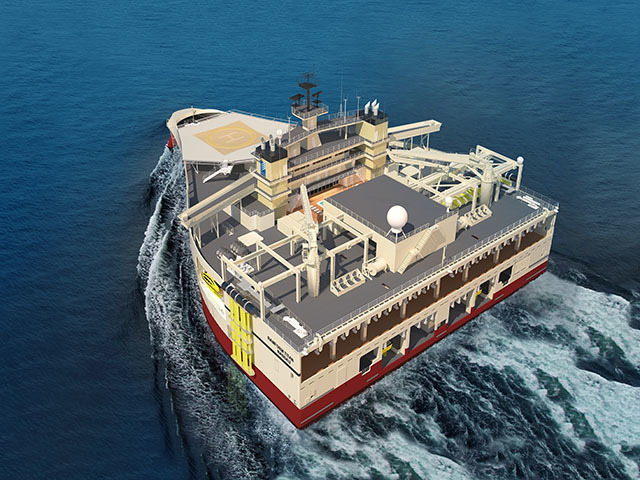
It is the most radical seismic vessel built to date and Norwegian owner Petroleum Geo Services (PGS) says that Ramform Titan will be the most powerful and efficient marine seismic acquisition vessel ever. It will also be the widest ship in the world at the waterline.
Titan is the first of four such sister vessels in the current build programme and all will dwarf prior Ramform survey vessels built for the company.
The Titan class is all bow and stern. The back end is 70m wide and is fitted with 24 streamer reels of which 16 reels are aligned abreast and eight are located further forward.
This massive spread is the largest developed yet. PGS says that the Titan will typically tow a network of several hundred thousand recording sensors over an area greater than 12sq.km, which is equivalent to nearly 1,500 soccer pitches, or 3.5 times the size of Central Park in New York.
The company says that the increased work space and advanced equipment mean safer and even more robust operations. Moreover, greater operational capacity is expected to translate into faster completion of surveys and increased uptime in marginal weather.
The period between major yard stays is also extended by 50%.
Jon Erik Reinhardsen, president and CEO of PGS, said of the new fleet addition: “Ramform Titan takes seismic acquisition to a new level. We have combined the most sophisticated technology in the business, with the most powerful and most efficient vessel in the industry. Ramform Titan further strengthens our fleet and will give us a clear competitive edge for the next decade.”
The ship will spend her first season working on multi-client projects in the North Sea.
Meanwhile, China Oilfield Services Limited (COSL) has signed for a 12-streamer seismic vessel, HYSY721, with Shanghai Shipyard.
HYSY721 will be a large-scale dual-source deepwater seismic vessel, which will primarily engage in deepwater operations and 3D seismic data collection.
The vessel will be capable of towing 12 streamers each 8,000m long. It will be equipped with dual-source eight-gun arrays.
The vessel is expected to be delivered in the second half of 2014, and is scheduled to deployment in the South China Sea – deepwater sector; plus it will be available to the global market.
And there’s a third seismic new-build, also to Norwegian account.
The ST324XT class vessel, designed by Skipsteknisk in Alesund, will be built at Kleven’s shipyard Myklebust Verft in Sande, Norway. It has been ordered by GC Reiber and will be operated by Dolphin Geophysical from Bergen.
The vessel has been designed to tow up to 20 streamers of length up to 12,000m.
Kongsberg Evotec, a Kongsberg Maritime company, will provide the complete back deck solution for handling of up to 20 streamers simultaneously, that is, winches, fairleads and so-forth.